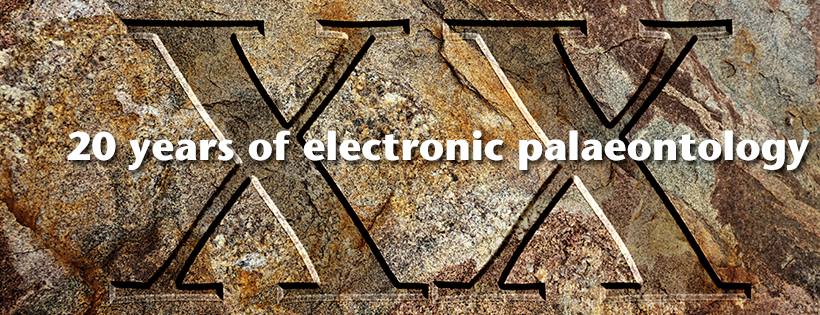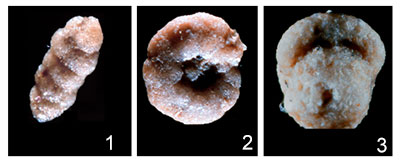“When we started [Palaeo Electronica] it was like a dare. Jump off that roof top, climb that tree, make an online journal.” – Jennifer Rumford

2017 marks the 20th anniversary of Palaeontologia Electronica (PE). For paleontologists, 20 years may not seem that long. But for the online, open-access journal PE, this represents a milestone that deserves celebration. The recently published commentary piece by Louys et al. offers a brief history of Palaeontological Electronica on the PE homepage . PE started in the early days of the internet in 1996; in fact it was one of the first peer-reviewed online academic journals in the world.
That isn’t the only first PE can claim, the journal’s other big achievements include:
- First primarily electronic journal of paleontology
- First species formally described online: Eggerella matsunoi, Haplophragmoides hatai, and H. nishikizawensis (Scott et al. 2000; Figure 1.)
- First scientific journal with a plain-language abstract
- First PDF “reprints” in paleontology
 First species names published in PE by Scott et al. 2000.
First species names published in PE by Scott et al. 2000.
Since 1996 PE has published hundreds of research articles, commentaries, and reviews. It has adapted with the times and joined Facebook in 2010 (now with 2528 likes) and Twitter in 2012 (now with 988 followers). It has evolved from a series of discussions on the PaleoNet listserver to a well-recognized journal for publication and dissemination of paleontological research and techniques.
Author and co-founder Dr. Norman MacLeod discussed some of the challenges to starting an entirely online journal in the 1990s. It is clear from his story how radical the idea of an electronic paleontology journal was for the scientific community. As Dr. MacLeod would say, “to some extent that concept looks a bit less radical now – with virtually all journals producing an electronic offer in some form – but its level of innovation at the time should not be underestimated.” Dr. MacLeod went on to write:
“Prior to PE other researchers in fields other than palaeontology - largely physics and  mathematics - had established a few “manuscript repositories” (for lack of a better term). These were indexed system where authors could upload papers they’re written and readers could find those manuscripts. These publications amounted to “grey literature” as no peer-review was involved in this process. On the positive side, they neatly stepped around the limitations, inconsistencies and delays involved with peer-review and so encouraged innovation, creativity and the publication of new ideas. On the negative side, the abandonment of review meant that the evidentiary standard was up to the author and reader to judge for themselves. Of course, authors and readers always need to do this irrespective of the publication format. But the critical difference is that the professional reputation of a manuscript repository as being authoritative really doesn’t apply to manuscript repositories in the same way as it does to a peer-reviewed journal. If you’re an author or a reader you ”click on the link and take yer chances”. With PE we wanted to find a viable middle ground between manuscript repositories and mainstream peer-review journals. So the first, and most important obstacle that needed to be overcome was the conceptual obstacle of where this middle ground lay and what sort of organizational infrastructure would be needed to deliver it.”
mathematics - had established a few “manuscript repositories” (for lack of a better term). These were indexed system where authors could upload papers they’re written and readers could find those manuscripts. These publications amounted to “grey literature” as no peer-review was involved in this process. On the positive side, they neatly stepped around the limitations, inconsistencies and delays involved with peer-review and so encouraged innovation, creativity and the publication of new ideas. On the negative side, the abandonment of review meant that the evidentiary standard was up to the author and reader to judge for themselves. Of course, authors and readers always need to do this irrespective of the publication format. But the critical difference is that the professional reputation of a manuscript repository as being authoritative really doesn’t apply to manuscript repositories in the same way as it does to a peer-reviewed journal. If you’re an author or a reader you ”click on the link and take yer chances”. With PE we wanted to find a viable middle ground between manuscript repositories and mainstream peer-review journals. So the first, and most important obstacle that needed to be overcome was the conceptual obstacle of where this middle ground lay and what sort of organizational infrastructure would be needed to deliver it.”
The original founders of PE spent a long time debating the innovations that this online paleontology journal would offer. Core aspects of PE include:
- Electronic only – no corresponding print publication
- No page charges and no subscription fees
- Articles published in html (for reading online) and in PDF (for archiving the referring to) formats
- Completely anonymous peer-review
- Complete freedom to use color and encouragement to explore new online technologies for delivering content
- Plain-language summaries written for all articles
- Abstracts translated into non-English languages
- Strong and proactive engagement with scientific news organizations (to facilitate communication of advances made to the general public)

As many readers are aware, other journals do not tend to offer this set of practices. Dr. MacLeod writes that this is either because these journals disagree with them (e.g., fully anonymous peer-review being fairer to authors than full-discloser or optional anonymity for reviewers peer-review), because they are too costly to produce (e.g., articles published in html and PDF formats), or, most recently, because they feel advances in technology have solved the problem (e.g., both abstracts and whole texts can be translated into a very large number of foreign languages by automated systems). It’s easy to demonstrate that such is not the case and indeed PE’s longevity, in itself, is that demonstration.
The founders of PE acknowledge that delivering these innovations does come at an organizational cost. Dr. MacLeod notes that this cost has mostly been borne by managing editor Jennifer Rumford, and it’s lucky that people like Jennifer exist. People like Jennifer stand at the heart of most scientific journals and publishers. PE remains a very different type of publication from any other scientific journal, paleontological or otherwise, which deserves recognition. The founders of PE surmounted countless conceptual obstacles and found a way to deliver results to colleagues. The costs of PE (copy editing, production costs, and any other miscellaneous costs) are funded by donations from Palaeontological Association, Paleontological Society, and the Society of Vertebrate Paleontology. In retrospect it was, and remains, an amazing achievement that the palaeontological community should be proud of.
At PE we are always looking at innovations that will improve the journal for both authors and readers. We are currently looking for funding in order to add Digital Object Identifiers (DOIs) to all articles published at PE, the cost of which exceeds our current budget (see for more information about DOI funding). Looking back to a traditional funding method for paleontology, we hope to find patrons to fund the cost of DOIs. You can be part of palaeontological history by joining our DOI patronage program.
You can learn more about the stories behind the making of PE in the recent commentary piece, Twenty years Online!, by Julien Louys, Andrew Bush, James W. Hagadorn, Norman MacLeod, R. Timothy Patterson, P. David Polly, and Jennifer Pattison Rumford.
Are you interested in publishing with PE? PE is seeking authors interested in writing research or technical articles, commentaries and editorials, and also book reviews. Get more information here.


